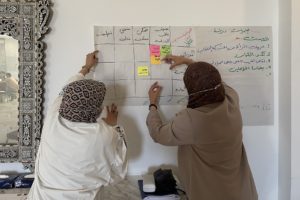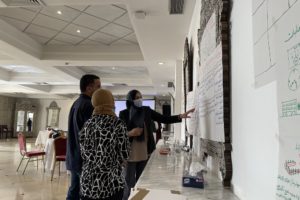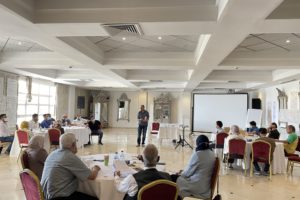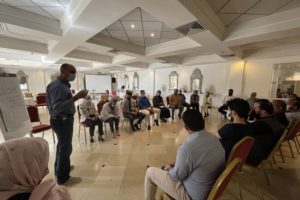This is the story of Tamzin, a Libyan community that maintained its neutrality and peace in times of conflict. Located in the Nafusa Mountains of Northwestern Libya, Tamzin is a small town with a population of about 6,000 people, slightly more residents than Interlaken, Switzerland. Like Interlaken, Tamzin has a pharmacy, snack shops, stores, places of worship and occasionally snow in the winter. Amidst years of war, Tamzin has remained peaceful, fostering good practices and serving as an example for neighboring towns.
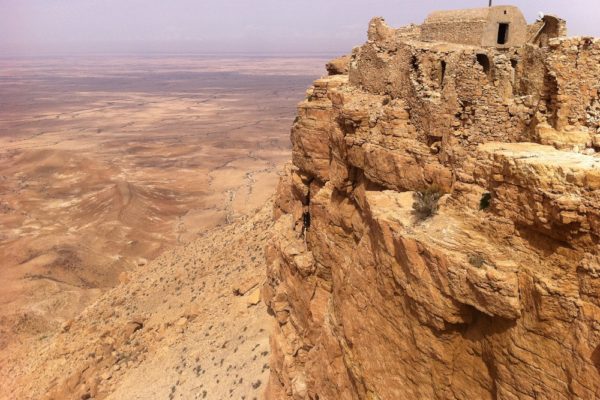
The Nafusa Mountains Valley, home of Tamzin and its neighbors. Photo credit: Ahmed Labnouj
Communities divide as political tensions rise
Since 2011, the legacy of the Libyan revolution resulted in continued political and social tensions. Across the country, communities that once co-existed peacefully, suddenly began to resurrect old wounds, which were fueled by historical disagreements. In 2014, issues between various Libyan political camps resulted in violence, which spread from Tripoli to Benghazi and other parts of the country. As a result, new political bodies emerged, which competed for followers and power. Some communities stayed impartial, while others actively supported one party over the other. The competition between these political parties extended throughout different communities and inevitably tensions worsened. In this troubled time, the community of Tamzin remained neutral.
Tamzin has a history of fostering and sustaining peace. At the height of the revolution, it was one of the few communities that was not militarized. Unlike other communities across Libya, it did not develop a military council or a heavily armed local militia.
Reducing violence through inclusive dialogue
Over a year ago, violence erupted between Tamzin’s neighboring towns of Kabaw and Tiji. These two communities struggled with fights on and off since 2011. As a result, the people of Tamzin, who had developed their dialogue facilitation skills with Interpeace, decided to get involved and reduce the tension between their neighboring communities. The people of Tamzin took advantage of their good relations with both communities, as well as their impartial reputation during moments of conflict, and worked with the people of Kabaw and Tiji to end the fighting, as well as help prevent it from spreading to other neighboring communities.
Traditionally in Libya, elders in the communities are the ones tasked with reaching out to each other to resolve community problems. The Tamzin people put in practice the new skills learned with Interpeace and promoted the participation of all sectors of the communities to identify and resolve conflict. In an attempt to put an end to the conflict between their neighboring communities, peacebuilders from Tamzin held consultations in Kabaw and Tiji, inclusive of all aspects of society for over a week.
According to Hassan[1], a Tamzin peacebuilder who facilitated discussions, “several methods and tips from Interpeace were used during those dialogue sessions. One of them was to trigger 'behind the scenes', informal moments to improve interpersonal relations over common values. After sharing traditional dates and buttermilk during a break, participants smoothened their tones and declared that since they had broken bread together, they should not leave the room without an agreement.”
By gathering all sectors of the communities, a clear peace plan between Kabaw and Tiji was established. To this day, the peace plan holds because it was lead and developed by the very people affected by the tensions, and as a result guaranteed its sustainability.
Asked about the evolution of the situation over the past year, Hassan reflected that “the dispute resolution enhanced stability in the whole Nafusa Mountain region.” According to him, improved relations between Kabaw and Tiji trickled down positively on the economic trade and social linkages of all communities, as illustrated by a rise in inter-communal marriages.
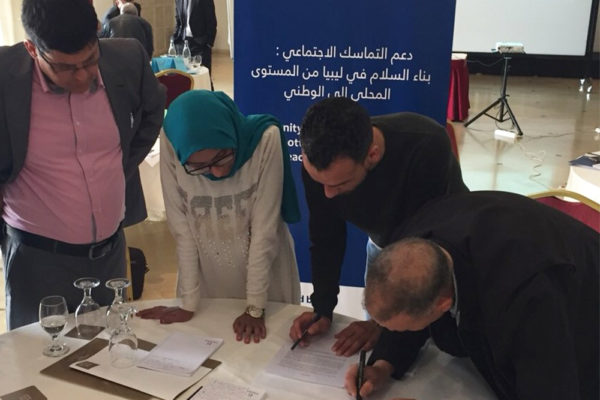
Change agents designing their community dialogue sessions during an Interpeace workshop in February 2018. Photo credit: Interpeace
A peace mapping process
Interpeace and its local partners have worked in Libya since 2011, with the aim of building an architecture for peace in the divided country. Through a peace mapping process, the views on obstacles to peace and stability of hundreds of Libyans have been documented, with the objective of highlighting the numerous, but less visible communities, that have remained relatively stable despite the conflict in the region.
Interpeace began working with the people from Tamzin in 2016, to better understand the conditions and coping mechanisms developed in the community to deal with the conflict that surrounds them – extracting the lessons learned from this community and others like it can help others across Libya build their own peace and stability. With the help of Interpeace, women and men from Tamzin were able to build on their own peaceful history and study more ways to help others engage in inclusive dialogue, without resorting to violence. For the past two years, community members learned to lead and facilitate dialogue to resolve problems, and created a group gathering over 200 people from the city, Tripoli and the diaspora, to mediate conflicts and seize joint opportunities for local regional development.
Learning from communities like Tamzin, that remain peaceful in conflict-affected environments, can help contribute to the overall peacebuilding and reconciliation efforts in Libya. By strengthening their capacity for resilience through dialogue and inclusion, violent conflict can be reduced in the region.
[1] The name has been changed to protect the identity of the dialogue facilitator.
